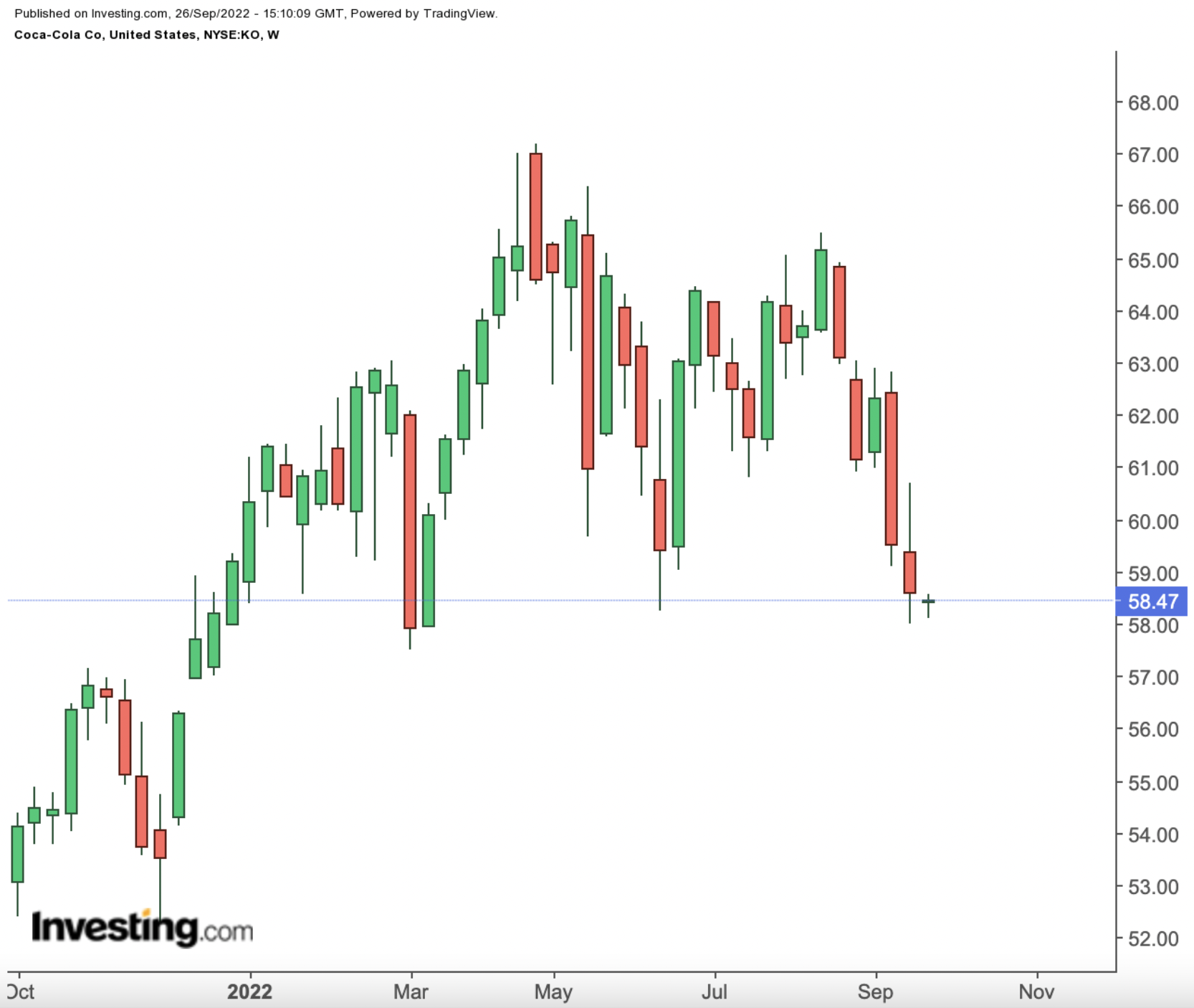- Coca-Cola stock has a reputation as a defensive play, immune to macroeconomic and inflationary concerns
- But history suggests otherwise: Coca-Cola struggled with growth even during a more beneficial period
- At the right price, KO stock is an attractive play. But even after a 10% sell-off in five weeks, the right price may not have arrived yet
Conventional wisdom would suggest Coca-Cola (NYSE:KO) is the kind of stock investors should be buying at the moment. Amid so much uncertainty — geopolitical, fiscal and economic — the safety of one of the world’s great brands should provide comfort and stability.

Source: Investing.com
On its face, that wisdom makes some sense. KO stock has been a multi-decade winner, and one of the biggest drivers of above-market returns in Warren Buffett’s Berkshire Hathaway (NYSE:BRKa) (NYSE:BRKb). Shorting the stock would be foolish in any environment, and expecting material multi-year downside is almost certainly too pessimistic.
That said, the conventional wisdom has some holes. Most notably, in past downturns, Coca-Cola stock indeed has tumbled. In the environment that’s created the current sell-off, the company faces one very real risk that doesn’t necessarily look priced in. And while the performance of both the company and the stock are impressive over the long haul, the past decade has been rather middling for both.
Indeed, there are too many risks here for KO to be seen as ‘safe.’ At the right time and the right price, shares may well look attractive, but right now, above $58, Coca-Cola stock is not what the conventional wisdom suggests it is.
The Growth Problem
Of late, Coca-Cola has outperformed. Including dividends, KO has returned 12% over the past year, against a 16% decline in the S&P 500. But that outperformance is a notable departure from recent trends.
Even after the last 12 months, KO has been a multi-year laggard. Three-year total returns in the S&P 500 are 30.8%, against 18.6% in Coca-Cola. Over a five-year period, the index has more than doubled KO; over a decade, it’s almost done the same.
The core reason why is that the business simply hasn’t grown fast enough. From 2013 to 2021, Coca-Cola’s reported adjusted EPS increased from $2.08 to $2.32. That’s total growth of 11.5% over the eight-year stretch, or about 1.4% on an annualized basis.
But even that anemic performance on a per-share basis actually overstates the trend in the underlying business. Coca-Cola’s tax rate declined over the period, thanks largely to corporate tax reform in the U.S. And, owing to share repurchases, Coca-Cola’s diluted share count declined.
Those two factors drove basically all of the growth in earnings per share. In 2013, Coca-Cola generated adjusted pre-tax profit of $12.2 billion. Last year, the figure was $12.4 billion.
Two Points In Coca-Cola’s Favor
To be fair, two factors played a key role in that stagnant performance.
The first is the company’s massive restructuring over much of the 2010s. Most notably, Coca-Cola embarked on a so-called “refranchising,” in which it overhauled its bottling network. The plan was to create a slimmer Coca-Cola focused more directly on sales of concentrate, improving operating margins in the process.
The second is that currency impacts have stunted the company’s growth. Over those eight years, the U.S. Dollar Index increased from 81 to 96 — implying a nearly 20% strengthening in the dollar.
A stronger dollar is a negative for Coca-Cola profits, as the company has more costs in dollars than revenue. The company does hedge this exposure somewhat, but not fully, and a weaker local currency also provides an advantage to in-country rivals.
It’s unfair, then, to presume that Coca-Cola’s business simply has stopped growing, and/or to use the stagnant pre-tax income to argue that the company won’t grow going forward. Indeed, the restructuring appears to have worked. After a strong second-quarter earnings report in July, Coca-Cola raised its full-year outlook. Even in an inflationary environment, consumers still want their Cokes.
Money Matters
There are two core issues, however. The first is that even a business performing well can’t completely negate the impact of the massive surge in the U.S. dollar of late. Excluding currency impact, Coca-Cola sees adjusted earnings per share increasing 14% to 15% for the full year. With currency, however, it’s projecting growth of just 5% to 6%.
That’s obviously a massive headwind. And if it holds, it adds another layer to Coca-Cola’s risk from inflation in markets outside the U.S. It’s one thing to ask consumers to pay a 10% higher price for soda. It’s quite another to expect a 10% inflationary rise and then 6% or 8% more to account for the reduced dollar revenue from a product priced in euros or yen. At a certain point, Coca-Cola margins are going to take a hit.
The second issue is that even with a steep pullback since mid-August, KO is hardly cheap. Shares trade at roughly 24x this year’s adjusted EPS guidance — a notably higher multiple than the stock historically has received.
Is that a price worth paying for safety? Some investors might believe so. But history is useful here. During both the 2008-09 crash and the 2000 bust, KO stock lost more than 30% of its value in less than a year. Another crash of that magnitude is not guaranteed from this point on, but that history shows that KO, too, can be a victim of broad market selling.
To be sure, it’s reasonable to look at these short-term risks and still see a potential long-term case. To some degree, that case is likely to play out.
What is not reasonable is assuming that KO stock will be immune to what’s going on around it. That’s simply not how it’s worked in the past, and almost certainly won’t be how it works this time, either.
Disclaimer: As of this writing, Vince Martin has no positions in any securities mentioned.
